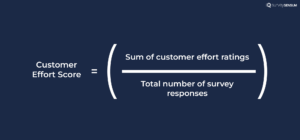9 Ways to Improve NPS Response Rates
Read More

You know how sometimes you interact with a brand, and it feels like you’re jumping through hoops to get things done? Like making a return, tracking orders, etc.
Well, that’s where Customer Effort Score comes in. It’s a way for businesses to measure how easy or difficult it is for their customers to achieve their goals or get help when dealing with the brand.
Imagine you had to rate your recent experience on a scale from 1 to 10, with 1 being super easy and 10 being really tough. That’s exactly what CES does – it asks customers to rate the amount of effort they had to put forth to accomplish their task or resolve their problem.
→ Brands evaluate their CES to figure out where their customers might be facing roadblocks.
But how to calculate CES effectively to improve retail customer satisfaction? Well with the help of an efficient CES software.
But how to do that? Let’s find out!
Why Measure Customer Effort Score?
How To Calculate Customer Effort Score in 4 Easy Steps?
Customers want quick, easy, and hassle-free shopping experiences which also extends to post-purchase. Measuring CES can help you reduce friction for an effortless experience and provide your customers with easy and convenient solutions.
Here are some points that explain why is customer effort score important:
Follow these 4 easy steps to measure CES for your business and reduce customer effort.
To calculate CES, you first need to gather customer feedback using a CES survey. The survey typically includes a single question that asks customers to rate the effort they put in to achieve their goal or resolve their issue. The scale is usually 1-5, 1-7, or 1-10.
Creating a clear and concise survey is essential to encourage a higher response rate.
For example,
“On a scale of 1 to 7, how much effort did you have to put forth to resolve your issue with us today?”
The scale can vary based on your preference, with 1 being “Very Low Effort” and 7 being “Very High Effort.”

Additionally, it is crucial to consider the timing and channels for survey distribution.
For example, sending the survey immediately after a support interaction or a completed transaction ensures that the experience is still fresh in the customer’s mind.
And use appropriate channels like email, in-app pop-ups, SMS, WhatsApp, or website widgets, depending on your customer’s preferences and engagement behavior.
Create Well-Designed CES Surveys With SurveySensum – Request a Demo

After collecting customer responses from the CES survey, the next step is to thoroughly analyze the data to gain valuable insights into the customer experience.
When analyzing customer feedback you must interpret the feedback within the specific context of the transaction or customer interaction. This is important to accurately understand the customer’s experience and the factors influencing their perceived level of effort.
To calculate the average CES score, add up the total number of responses for each CES score. Next, multiply the number of responses for each score by its corresponding CES score.
For example, if three customers rated 2, you would have 3×2 = 6. Next, sum up the results of the multiplication.
Finally, divide the total sum by the total number of responses to get the average CES score. The average CES score provides an overall representation of how easy or difficult customers find it to interact with your company.

First of all, there is no clear industry standard when it comes to a good CES due to the varied questions and metrics used.
Having said that, a good CES score generally falls on the lower end of the scale, close to “Very Low Effort” or “1” on the scale. Scores in the range of 1 to 3 are typically considered good, indicating that customers find it easy and straightforward to do business with your company.
Let’s say you run an online electronics store. A low CES score in your post-purchase survey could mean that customers find it effortless to track their orders, manage returns, and get assistance when needed. This suggests high satisfaction and a smooth shopping experience.
However, if your average CES score is high, it signals that customers are finding it challenging to navigate your website, locate product information, or get timely support. This highlights areas where you could enhance your website’s user interface, improve product descriptions, or streamline your customer support processes.
But, what is the exact issue?
CES alone can’t tell you. That’s why you need to accompany CES with NPS or CSAT
If your NPS is high and CSAT is positive, it aligns with a low CES score, indicating strong customer satisfaction. Conversely, if NPS and CSAT are lower and CES is high, it signals potential areas needing attention to boost overall customer satisfaction.
Acting on feedback received from CES surveys is crucial to address pain points, streamline processes, and enhancing the overall customer experience. By actively responding to customer feedback and making improvements, you can foster customer satisfaction – ultimately leading to business growth and success.
Measuring Customer Effort Score (CES) is a crucial practice for businesses looking to understand and improve their customer experience. It will help you in identifying customer pain points, enhance your customer experience, optimize your support processes, and increase referrals through customers.
Use effective customer feedback management software like SurveySensum to collect customer feedback through well-designed CES surveys and make this process “extremely easy”.
CES serves as a key performance indicator, enabling organizations to make data-driven decisions and create lasting connections with their customers. But don’t stop there, supplement your CES surveys with NPS and CSAT surveys to get a complete picture and fine-tune your customer experience accordingly.
